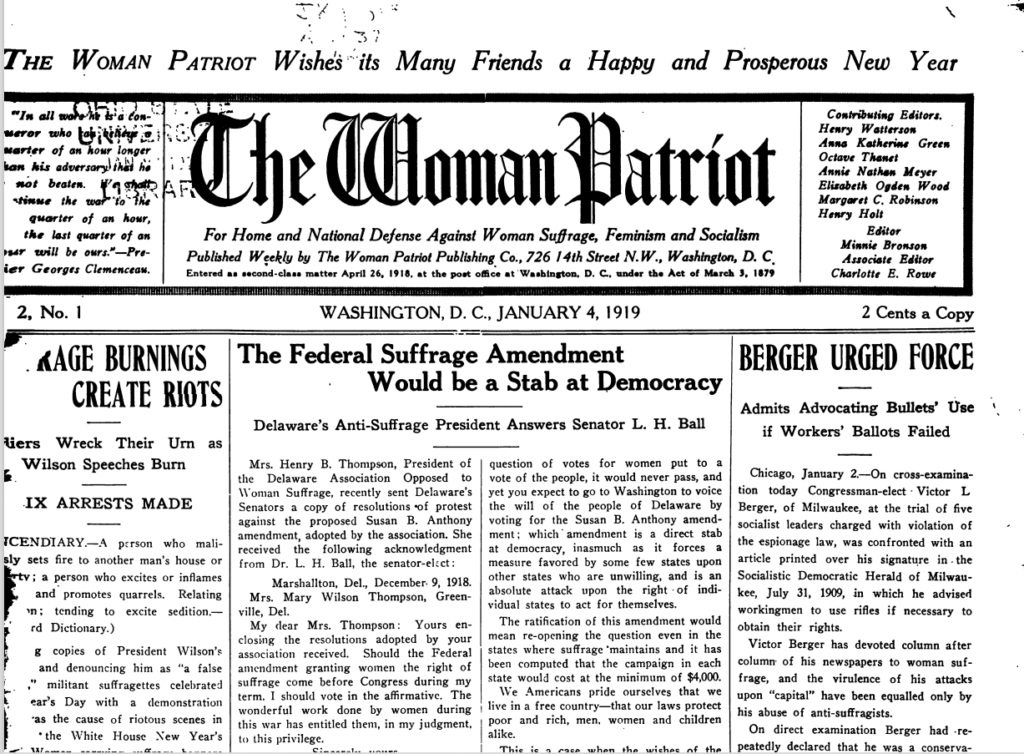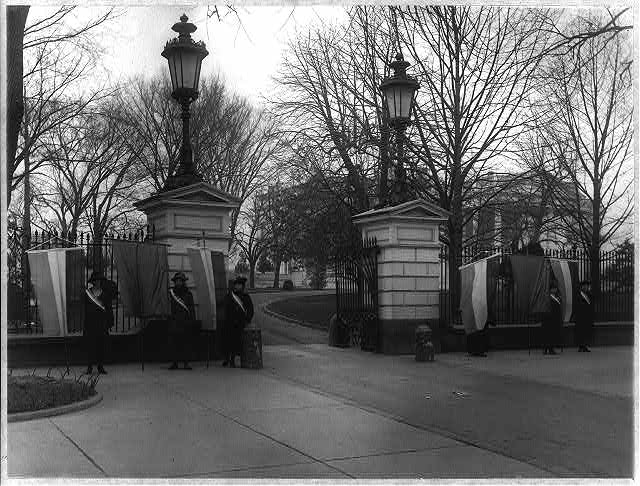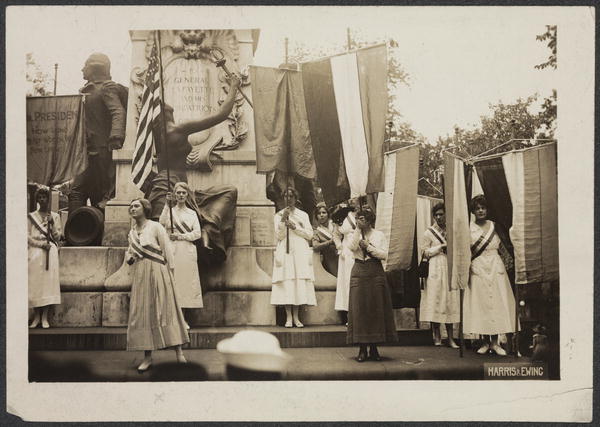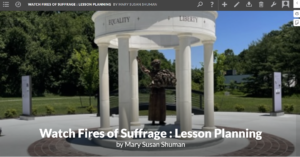Will be on scalar! Alliance for Networking Visual Culture (scalar.me)
Category: Assignments
Final Project Update
The current state of the final project is making pages on a Scalar project focused on women’s suffrage in the United States and the three groups, National Women’s Party, National American Women’s Suffrage Association, and National Opposition to Women’s Suffrage Association. It is a focused look at the events of the Watchfires at the end of 1918 and into 1919. My intended audience has changed to undergraduate students and students interested in learning how to do some digital history work by adding to an interactive book on Scalar. Once I publish the website, it will be a lesson plan and scavenger hunt for sources about the watchfires, anti-suffrage propaganda, and any relevant primary sources. I hope students learn and discover how women’s suffrage was voted down in the fall of 1918 and how the National Women’s Party thought that Woodrow Wilson had more influence on Congress passing the amendment. I have limited the time to 1918 and 1919 to help direct students for sources. There are many websites about women’s suffrage and focusing on the last year and a half teaches students the hurdles and how Woodrow Wilson went to Congress asking to pass the 19th amendment as a war measure. The challenges I have encountered is that I am also learning how to use scalar and about woman’s suffrage simultaneously, so it is hard to change from being a student to formulating a lesson plan to teach about these events. I am reading other learning plans offered about voting from the National Archives called DocTeach and trying to incorporate some of this type of historical thinking questions into the website. I need to continue growing the website with questions and analysis examples for students to contribute and even author new pages. Once the website is close to a preliminary mockup, I can make it public, and it will be accessible to anyone to use, comment, and review.
Project Update
Project Promotion
Made with Adobe Illustrator and Canva
Source: The Woman Patriot. January 4, 1918. Google Digitized Book. Public Domain

What was a watchfire? How were these demonstrations reported in the press? Anti-Suffragists called it riots, see photo below of the watchfire. Lesson will include historical evaluation of these events and at least three primary sources.

Movies as History Media
I think films are an excellent medium to expand on the historical events or people in history. Historical thinking is a way to critically analyze within the context of the time that primary sources were written. This type of thinking critically should and could be applied to movies. While films are dramatic reinterpretation of events, these films can reveal information to the general public that may not have been known. Films like Iron Jawed Angels is a prime example of this. I did not know that women were arrested, and force fed in jail during hunger strikes just due to the peaceful protest during World War I. Films like Hidden Figures, Iron Jawed Angels, and Silkwood have been about female figures in history that may not have been fully realized or known by the general public. These are films that I would like to consider using to open a door into historical thinking about events. Since these events are not as well known, these films can open new interest in evaluating the primary sources and documents around events, people and their history.
For scholarly digital storytelling, small and shorter video projects can be used to teach the user and the audience about different historical topics. The skills to write and publish short digital history makes the learner focus on the intended audience, a streamlined history to keep the audience’s attention while informing their audience, and an awareness of the audience that you do not need in a traditional historical essay. Depending on the project, the learner could also learn technical skills for editing, sound, video, and oral presentation and interviewing skills. Oral interviewing as an historian is important skill to learn for oral histories and archives. Digital story-telling projects can be tailored and added as primary and secondary sources to past histories of events or people.
Movie Review for Project
Write a blog post addressing the following:
FILM METADATA: List the basic information (metadata) about the film, including title, year, producer, and how you accessed the film. If this film is based on primary or secondary sources, mention that as well.
BIG THEMES: Think carefully about the big themes related to this topic. How does the film portray those themes? What is historically accurate and what is historically inaccurate?
KEY MOMENTS: Describe 2 key moments in the film [up to 5 minutes per moment] that either addressed the larger themes or were especially important in the representation of the historical moment or event. Include the time stamp for the two moments.
TEACHING AND LEARNING: Having evaluated (or reevaluated) this film, would you use it in your history education context? How would you introduce the film and issues of historical accuracy? What questions would you pose? What questions would you want learners to ask?
Iron Jawed Angels (TV Movie 2004) – IMDb
Film Metadata: Iron Jawed Angels: Lead, Follow, Or Get Out of the Way
2004
Director Katja Von Garnier
Playing on HBO MAX June 2022.
Primary Sources: Jailed for Freedom by Doris Stevens and multiple images on Library of Congress.
Big Themes: The film portrays women in the National Women’s Party with a biographical focus on Alice Paul. The themes are the suffragist’s protests, the arrests and the women at the Occoquan Workhouse when jailed, and hunger strikes with Alice Paul being force-fed. The movie ends with the passage of the 19th amendment, and it comes across that this occurs totally due to these protests with Woodrow Wilson being against the suffragists the entire movie. Historically, hunger strikes did occur, and suffragists were sent to jail from their silent sentinel for the fake charge of obstructing traffic. The charges were considered harsh and arrests at first led to women being let go to actual imprisonment during their protests in World War I. In an early scene for one of the suffragist’s parades and the violence to the suffragists, did occur. The parade route at the beginning of the movie did get violent, in fact, Congress had a hearing to investigate the DC Police for not protecting the suffragists in the parade. Big Theme is violence and arrests to peaceful protestors.
Key Moments: Several key moments in the movie included that convey what the women of the National Women’s Party went through to push for the vote for women include: the parade where the suffragists are attacked by the crowd, arrests of the suffragists continuing the silent sentinel efforts during World War I, and when Alice Paul is being questioned by a doctor for her sanity since she is on hunger strike in jail and he stated that she is not insane Time Stamp : For the parade and violence against them 21:10 to 25:50, which leads to the newly inaugurated President to meet with them. Then the violence against the women during World War I and the arrests is at 1:17-1:23 with prison and putting on prison clothes. (The women later took those prison clothes and went across the country to bring awareness on the issues and how they were jailed for protesting nonviolently). Watchfire/bonfire is at time stamp 1:30. Alice Paul being questioned by doctor on insanity and his report to Woodrow Wilson that she is not insane and was like Patrick Henry. “Give me liberty or give me death.” ends at 1:38
Teaching and Learning: I would use this film for history education as the women in the National Women’s Party did do these protests. In fact, this movie has a long lesson plan and evaluation on a website called Teach with Movies. This movie did show one watchfire scene (which is the focus for my lesson plan) and they get arrested and sent to jail. While in jail, Alice Paul is separated from the other suffragists and goes on hunger strike until she was forcefully fed. Questions I would hope from students. Did this really occur? What really happened to the protestors? Who was Alice Paul? What was her importance? Was Woodrow Wilson truly that obstructionist to suffrage?
My questions would be: Did their efforts help or hinder the suffrage cause? Assignments could be to support either stance based on primary sources. The movie makes it seem that the National Women’s Party efforts are what achieved success and leaves out the significant work done and made by NAWSA in Congress. There is a full lesson plan for this movie done very well on a website. Other questions could lead a student to analyze how protests from the past are similar or dissimilar to today? How did these white women treat native American women and black women who wanted the vote? The politics of each individual senator and lobbyist efforts by the NAWSA is not delved into like the primary documents. In Congress there was a significant overlap in prohibition and anti-prohibition, “states’ rights” and that the U.S. Constitution does not guarantee the right to vote and that each state should decide on women’s suffrage. What recent Supreme Court brief touches on these same themes that were against a federal amendment for a woman’s right to vote?
Third Piece of Puzzle

Third Puzzle Piece
So far, I have found a primary source from each organization that I want students to analyze and think about the words used in these sources to describe demonstrations, the President, and propaganda in light of World War One. These sources are long and will have to be narrowed to specific protests; I may narrow them down to the peace talks in France in December of 1918, as this was when the National Women’s Party escalated to the watchfires. There are not many descriptions in the newspapers of these events, maybe due to the overwhelming coverage of Woodrow Wilson in France.
One, The Front Lobby, describes the work of the lobbyist of the NAWSA, and she explains how the suffragists worked in Congress to get support for Susan B. Anthony Amendment. In this source, the work of the NAWSA is contrasted with the “militants” of the movement. The second source is the book, Jailed For Freedom as the source from the National Women’s Party. This source described the work by the National Women’s Party, the “militant” suffragists with their DC silent sentinels, to the watchfires and protests from 1917 to the passage of the 19th amendment. The third source is “The Woman Patriot,” a DC newsletter written by anti-suffragists who described the activities of the suffragists as riots, socialists, and pro-German and anti-patriotic.
Other sources I have found and plan to incorporate possibly are the African American paper, The Washington Bee, and additional newspaper articles about protests in Washington, DC. I also will contain links to all the different websites that include further information on the overall history of suffrage. This lesson is limited to the years before the passage of the 19th amendment and the language used by the different groups with propaganda during World War I and after. Images I also plan to use are pictures of the watchfires, which are limited but need to be included and can be analyzed along with the primary documents. I will help the audience with the images based on the dates and background of World War I dates since this is a focused segment on woman suffrage and anti-suffrage.
Document Sources so far
Park, Maud Wood, Carrie Chapman Catt, and National American Woman Suffrage Association Collection. Front Door Lobby. [S.l.: s.n., 192, 1920] Manuscript/Mixed Material. https://www.loc.gov/item/93838361/.
Stevens, Doris. Jailed for Freedom. United States: Boni and Liveright, 1920. Library of Congress.
The Woman Patriot. United States: Woman Patriot Publishing Company, 1918.mGoogle Digitized.
Richmond times-dispatch. [volume] (Richmond, Va.), 02 Sept. 1919. Chronicling America: Historic American Newspapers. Lib. of Congress. <https://chroniclingamerica.loc.gov/lccn/sn83045389/1919-09-02/ed-1/seq-4/>
Images
These images in the list may be used for this lesson plan, and is not the final list. These images show the events of the suffragettes who picketed at the White House, a political cartoon, and an ad. All of these were during or immediately after World War I. I would also like to find anti-suffrage images to add to the lesson for analysis. The challenge I am seeing is—ok, so I have these different sources for evaluation. What do I want the class and objectives to be? What website do I want to develop? Omeka or Google sites? What will the website do? Do I make it interactive or just a lesson plan to compare the sources? With the focus on DC, Virginia, and Maryland, I could also add a segment. For example, find a voice from either side and write an analysis of how you researched the person, where she was within which group, and her importance. There are many women in the Equal Suffrage League of Virginia, the Suffragist (National Women’s Party), Maryland Suffragist News, National Women’s Suffrage Association, and the Woman Patriot and Women Opposed to Suffrage that could be researched and discuss their contribution to their organization. I also want to show how World War I and suffrage propaganda helped further their cause. At the same time, anti-suffragists also used World War I terminology and words in opposition to women’s suffrage. Women’s suffrage was supported in the Washington Bee, and African American newspapers that could also be added despite the racism found in the documents by all three organizations.
[Two suffragettes and bonfire at front gate, White House, Washington, D.C.] (loc.gov)
3c13716r.jpg (640×512) (loc.gov)
Harris & Ewing, Washington, D.C. Party watchfires burn outside White House, Jan. United States Washington D.C, 1919. Jan. Photograph. https://www.loc.gov/item/mnwp000303/.
The Washington times. (Washington, DC), Jan. 9 1918. https://www.loc.gov/item/sn84026749/1918-01-09/ed-1/.

Harris & Ewing, Washington, D.C. Suffrage demonstration at Lafayette Statue to get the last vote in the Senate before June 4. United States Washington D.C, 1918. [Sept. 16] Photograph. https://www.loc.gov/item/mnwp000191/.


. United States Washington D.C, 1919. Jan. Photograph. https://www.loc.gov/item/mnwp000303/.
Digital media of primary sources and the ability to evaluate the use of words to tell a narrative allows students to dissect the narrative about specific events, like the final years before the 19th amendment. Digital media with the digitization of images, congressional records, and newspapers allows the student to evaluate the anti-suffrage movement and the choices of their words to fight the protests and lobbying efforts of the NAWSA and National Women’s Party. I plan to focus on the DMV area and the local efforts by anti-suffrage groups, specifically the publisher and the newsletter called “The Woman Patriot.”
The Woman Patriot newsletter continued after the 19th amendment passed. The arguments within this newsletter reveal propaganda associating suffragists with socialists, feminists, Bolsheviks, and pro-German during WWI. Allowing a side-by-side comparison of word usage like riots, pro-German, socialism, feminism, and militant from anti-suffrage to suffrage newsletters could allow word and topic modeling within the texts. This may shape my final project as word usage in newsletters, lobbying efforts, and protests could be compared. Both sides used the background of patriotic propaganda of World War I to further their cause. In the Woman Patriot, the outline of what they stood for clear. Women were to be the stewards of the home and not involved in politics. This was the best way to honor the men fighting in World War I. E By exploring the words used by the three main groups, DC anti-suffragists, NAWSA, and National Women’s party, the student can analyze how the World War I propaganda were part of these newsletters that have all been digitized. This shapes my final project pitch based on how students interpret these different primary sources and think about how the words used during World War I were employed by anti and suffragists alike. The digital programs to do text analysis of the documents of “The Woman Patriot” and newspapers could be run through voyant or Mallet for topic modeling only if I can teach myself quickly enough in time to see this data visually and if this helps teach students about how to look at the suffrage movement in context of anti-suffrage, especially in Washington, DC. Interestingly, there are quotes from Capital police when arresting suffrage demonstrators who talked about how they do not have the vote either since they live in DC. Just an interesting tidbit I ran across about suffragists being brought down to the level of a DC resident.
Realistically, for this class and the short amount of time, a more teaching type of exercise may include a museum type exhibit of images and several textual primary sources on the one event of burning Wilson’s speeches and how this was described based on anti-suffrage versus the competing suffragist groups. “The Woman Patriot” termed this event as a riot and other sources described this event as a protest, or militant protest and have the student evaluate the different primary sources to contextualize and form their own narrative about the event and if these events helped or hindered public opinion about women’s suffrage could be a good lesson plan.
History teaching has changed in the late 20th and 21st century with the digitization of primary sources and the free-flowing access to information on the internet. While this has improved students’ access to information, especially college students who can access paid databases that their respective college subscribes to, it does not necessarily teach how to do a good analysis of these sources. The importance of history teaching is the same as it was when Carl Becker’s addressed the American Historical Association and described that everyone is a historian.[1] At the heart of history teaching, is how to teach students to think critically about sources within the context of the time they are written. With the improved access to primary sources due to digital access, this teaching has become even more fundamental. If you agree with Carl Becker that everyone is a historian, then teaching history in this way will help everyone think more critically about their own past and the country they reside in.
Over the last twenty years, history teaching has attempted to evolve from coverage teaching of facts within textbooks, to teaching historical thinking about sources and narratives. A significant push for historical thinking is from SoTL, Standards of Teaching and Learning. “Early on, history SoTL specialists realized that one of the most important tasks in front of them was replacing the coverage model’s understanding of what it means to be proficient at history—which unintentionally reinforced public misperceptions of history as important things that happened—with new understandings of expertise based on how historians think and tuned to how people learn.”[2]History textbooks in the United States have overall been mass-produced by four major publishing companies and do not truly teach historical thinking. [3] External constraints on teachers by the few narratives in USA history textbooks can be alleviated by digital access to sources, alternative narratives that are made free for teachers and students, and continued dedication to encouraging the questioning of narratives. The AHA Tuning project is a way to assess teaching and learning about history that adopts technology and techniques to improve and measure historical thinking.[4]
Digital techniques for assessing primary sources through analysis using computer-generated programs like word analysis and networks within primary documents is just one example of 21st century learning that can help teachers escape the constraints of textbooks. Many digital humanities and websites also have learning plans and exhibits online that expand the narrative on events or people to help learners develop historical thinking skills. These new techniques for teaching history with a focus on digital content that can improve teacher skills for historical thinking allows a freedom of expression away from standard textbooks and are an adjunct to text and primary source analysis.
[1] Edward L. Ayers, Everyone Their Own Historian. Journal of American History Volume 105, Issue 3, December 2018, Pages 505–513, https://doi-org.mutex.gmu.edu/10.1093/jahist/jay276
[2] Lendol Calder and Tracy Steffes. “Measuring College Learning in History.” Social Science Research Council. May 2016.
[3] Hyde, Anne. AHA History Tuning Project: 2016 History Discipline Core. American Historical Association.
[4] Lindaman, Dana, and Kyle Roy Ward. Introduction History Lessons: How Textbooks from Around the World Portray U.S. History. New York: The New Press, 2004.
Summer Project 2022
In this activity, describe your initial idea for a final project. What is your main topic? What kinds of primary sources might you use? Who is your intended audience and how will they engage with the project?
My initial idea was to further evaluate women physicians from the eclectic medical college in Cincinnati (from last semester’s project) who also became activists for women’s right to vote, like Alice Stockham. This led me to early female physicians who also were suffragists, like Harriot Keza Hunt and Dr. Anna Shaw. I may not keep this focus, but this is my starting point. So far, my early primary sources will be the women’s magazine archive, the library of Congress, and the Library of Virginia. Initially, I was also fascinated by the National Women’s Party and the fires they had in front of the White House on New Year’s Day, 1919, so I may incorporate that and how the movie, Iron Jawed Angels, depicted this compared to the primary sources about the events. The anti-suffragist paper “The Woman Patriot” described this event as a riot. However, since there is a movie and a teaching exhibit website done by the Library of Congress about these events already, I may need to change my focus to local or state archives and have been looking at the Ida Mae Thompson archive at the Library of Virginia. I may make a trip there to look at some of the materials on the Equal Suffrage League of Virginia and see if I am allowed to take photos and digitize them as primary sources for a focused website. Virginia did not ratify the amendment for women to vote until 1952. The suffrage movements and anti-suffragist primary sources are plentiful and digitized at the Library of Congress website. Still, the state of Virginia has a lot of boxes of suffrage material in Richmond and could see what that is there has not been digitized and do a website on a few materials there. The audience will be students interested in USA history and women’s history. I hope to get some guidance on narrowing the topic to maybe one person or event within the women’s suffrage movement.
